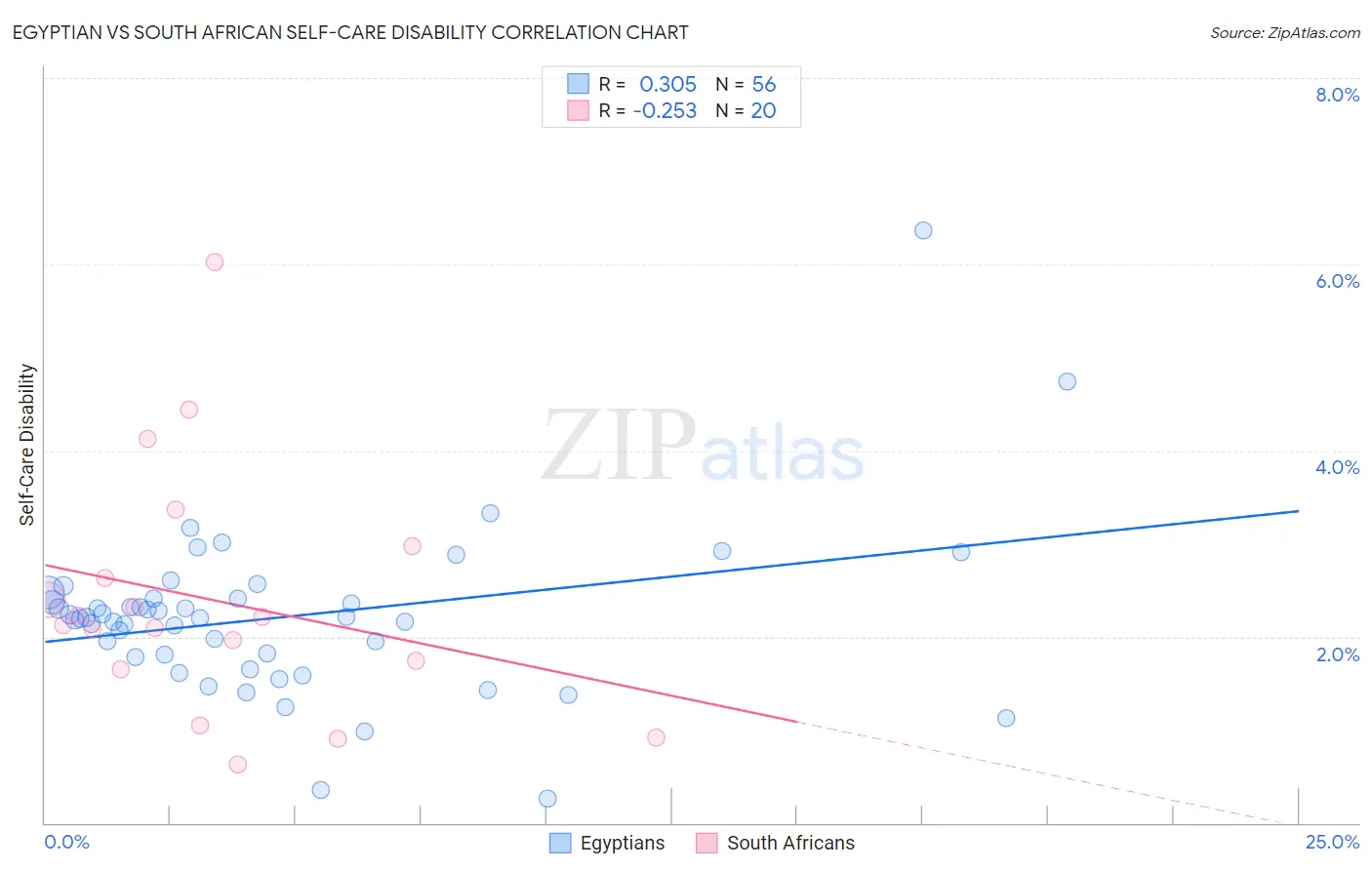Egyptian vs South African Self-Care Disability
COMPARE
Egyptian
South African
Self-Care Disability
Self-Care Disability Comparison
Egyptians
South Africans
2.3%
SELF-CARE DISABILITY
99.4/ 100
METRIC RATING
62nd/ 347
METRIC RANK
2.3%
SELF-CARE DISABILITY
99.3/ 100
METRIC RATING
67th/ 347
METRIC RANK
Egyptian vs South African Self-Care Disability Correlation Chart
The statistical analysis conducted on geographies consisting of 276,732,950 people shows a mild positive correlation between the proportion of Egyptians and percentage of population with self-care disability in the United States with a correlation coefficient (R) of 0.305 and weighted average of 2.3%. Similarly, the statistical analysis conducted on geographies consisting of 182,494,090 people shows a weak negative correlation between the proportion of South Africans and percentage of population with self-care disability in the United States with a correlation coefficient (R) of -0.253 and weighted average of 2.3%, a difference of 0.22%.

Self-Care Disability Correlation Summary
| Measurement | Egyptian | South African |
| Minimum | 0.26% | 0.63% |
| Maximum | 6.4% | 6.0% |
| Range | 6.1% | 5.4% |
| Mean | 2.2% | 2.4% |
| Median | 2.2% | 2.2% |
| Interquartile 25% (IQ1) | 1.8% | 1.7% |
| Interquartile 75% (IQ3) | 2.4% | 2.8% |
| Interquartile Range (IQR) | 0.61% | 1.1% |
| Standard Deviation (Sample) | 0.90% | 1.3% |
| Standard Deviation (Population) | 0.89% | 1.3% |
Demographics Similar to Egyptians and South Africans by Self-Care Disability
In terms of self-care disability, the demographic groups most similar to Egyptians are Palestinian (2.3%, a difference of 0.090%), Mongolian (2.3%, a difference of 0.090%), Swedish (2.3%, a difference of 0.090%), Brazilian (2.3%, a difference of 0.16%), and Immigrants from Japan (2.3%, a difference of 0.19%). Similarly, the demographic groups most similar to South Africans are Immigrants from Argentina (2.3%, a difference of 0.030%), Brazilian (2.3%, a difference of 0.060%), Immigrants from Zaire (2.3%, a difference of 0.090%), Immigrants from Norway (2.3%, a difference of 0.090%), and Swedish (2.3%, a difference of 0.12%).
| Demographics | Rating | Rank | Self-Care Disability |
| Argentineans | 99.6 /100 | #54 | Exceptional 2.3% |
| Immigrants | France | 99.6 /100 | #55 | Exceptional 2.3% |
| Immigrants | Eastern Asia | 99.6 /100 | #56 | Exceptional 2.3% |
| Immigrants | Belgium | 99.6 /100 | #57 | Exceptional 2.3% |
| Immigrants | Cameroon | 99.6 /100 | #58 | Exceptional 2.3% |
| New Zealanders | 99.5 /100 | #59 | Exceptional 2.3% |
| Immigrants | Japan | 99.5 /100 | #60 | Exceptional 2.3% |
| Palestinians | 99.4 /100 | #61 | Exceptional 2.3% |
| Egyptians | 99.4 /100 | #62 | Exceptional 2.3% |
| Mongolians | 99.3 /100 | #63 | Exceptional 2.3% |
| Swedes | 99.3 /100 | #64 | Exceptional 2.3% |
| Brazilians | 99.3 /100 | #65 | Exceptional 2.3% |
| Immigrants | Argentina | 99.3 /100 | #66 | Exceptional 2.3% |
| South Africans | 99.3 /100 | #67 | Exceptional 2.3% |
| Immigrants | Zaire | 99.2 /100 | #68 | Exceptional 2.3% |
| Immigrants | Norway | 99.2 /100 | #69 | Exceptional 2.3% |
| Immigrants | Northern Europe | 99.2 /100 | #70 | Exceptional 2.3% |
| Asians | 99.2 /100 | #71 | Exceptional 2.3% |
| Eastern Europeans | 99.2 /100 | #72 | Exceptional 2.3% |
| Immigrants | Egypt | 99.1 /100 | #73 | Exceptional 2.3% |
| Immigrants | Switzerland | 99.1 /100 | #74 | Exceptional 2.3% |